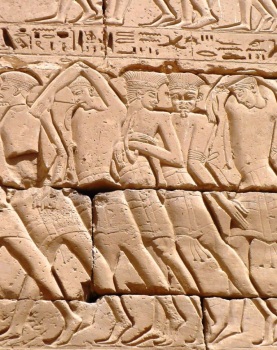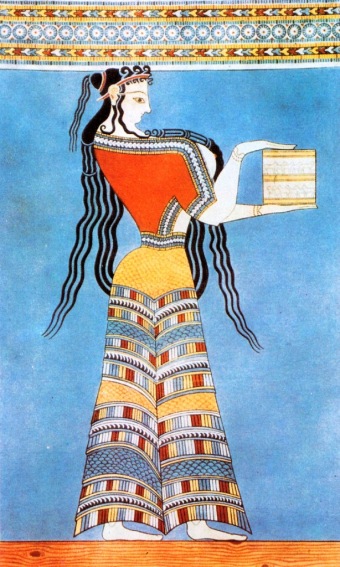Chronicle 18. AEGEAN: KNOSSOS, MYCENAE, TROY
/ΕΛΛΗΝΙΚΑ/ Χρονικό 18. ΑΙΓΑΙΟΝ: ΚΝΩΣΟΣ, ΜΥΚΗΝΑΙ, ΙΛΙΟΝ
● Stonehenge ● Dorians and Sea Peoples ●
Mysteries ● Trojan War and Bronze Age Collapse

The Atreid dynasty palace at Mycenae
AS HEIRS OF THE MINOANS, the Mycenaeans assumed control of “Tin Routes” – i.e. the maritime trade network of metals from the Occident. Their acme lasted for about 250 years until the Bronze Age collapse. This extensive network sheds light on the reason why Mycenaean artifacts have been found well outside the boundaries of the Mycenaean world: swords located as “far away” as Georgia in the Caucasus; an amber object inscribed with Linear B symbols in Bavaria, Germany; double axes and other objects dating back to the 13th century BCE in England (Wessex, Cornwall) and Ireland. There is convincing evidence that during the final phase of construction of Stonehenge in Wiltshire, around 1600 BCE, those builders there had commercial contacts with “the great contemporary Mediterranean civilizations”, as the astronomer Gerald Hawkins wrote, that is, “Minoan Crete, Mycenaean Greece, Egypt, and the ancestors of the travelling-trading Phoenicians.” The grave of a Mediterranean teenage boy, who died c. 1550 BCE, and several items of Mediterranean origin, have been found in the burial ground of Stonehenge.
-
● Hence, according to Hawkins, the Mycenaeans were already included among the navigating merchants of long distance voyages even before the conquest of Minoan Crete, together with the “ancestors of the Phoenicians”. The English astronomer and author, famous for his work in the field of archaeoastronomy,(1) published an analysis of Stonehenge in 1965 and was the first to propose the purpose of this megalithic monument as an ancient astronomical observatory to predict movements of the sun and stars. (See Chronicle 3, on Stonehenge as a work of migrants from the cradle of Homo, i.e. the Aegean, and also on the kinship between Minoans and Mycenaeans).
- (1) Archaeoastronomy: the study of how people in the past “have understood or used phenomena in the sky, and what role the sky played in their cultures.”
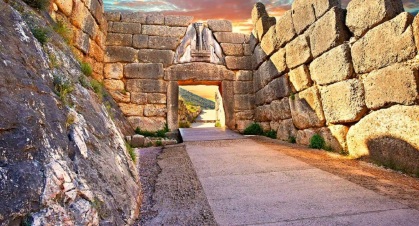
Mycenae, Lion Gate
The Mycenaean era (c. 1700 – c. 1100 BCE) is the historical setting of much myth and literature of the Hellenes such as the Epic Cycle and Greek tragedy. Scholars have traditionally blamed the collapse on an uprising, or an invasion by another Hellenic ethnic group, the Dorians, though at least one Mycenaean centre, Pylos, was most probably destroyed by the so-called Sea Peoples. There are theories of natural disasters or large-scale drought, which could have contributed, too. The movements of people from the Balkans and Asia Minor to the Near East at that time have been attested. The internal factors theory has the Mycenaean culture falling in the course of societal conflicts brought on by a rejection of the palatial system by the underprivileged strata of society, which were quite impoverished by the period’s finale. Another hypothesis mingles social with ethnic divisions. In this context let’s have in mind that the Iron Age made large numbers of rather cheap weapons accessible to all. War was no longer an aristocratic privilege. The iron weapons were not as good as the bronze ones but they could still kill… (See the previous Chronicle, footnote 6).
-
● The Dorian invasion is a concept devised by ancient Greek historians to explain why pre-classical dialects and traditions in southern Hellas were replaced by others that prevailed in the classical era. The Dorians, a Greek legend asserted, took control of the Peloponnese in the so-called “Return of the Heracleidae”. The meaning of the concept changed several times, as historians, philologists, and archaeologists, used it in vain attempts to explain the cultural discontinuities expressed in the data of their fields. The pattern of the arrival of Dorian culture on certain islands, such as Crete, is also not well elucidated. Despite some 200 years of investigation, the historicity of the Dorian invasion has not yet been established.
-
● The Sea Peoples were an alliance of seafaring raiders from southern and central Europe, and the Mediterranean Sea, especially the Aegean area, who sailed (and also marched) east invading Hatti, Cyprus, Syria, Canaan, and Egypt, and bringing about the Bronze Age collapse. Pharaoh Merneptah explicitly refers to them by the term “the foreign countries (or peoples) of the sea”. Leaving Mycenaean Hellas out of the list of the victims, some scholars believe they can identify most of the Sea Peoples mentioned in Egyptian records; they supposedly were the: Ekwesh–Achaeans (if they were, why should they destroy Pylos? “Because they were Hellenes!”, is the sardonic answer); Teresh–Tyrrhenians (the ancestors of the Etruscans); Lukka–Lycians; Sherden–Sardinians; Shekelesh–Sicilians; Tekrur-Teucrians (who might have been… either Trojans or Greeks); and Peleset–Philistines (Palestinians?), allegedly coming from Crete. The Peleset and Tekrur were the only major Sea People tribes that settled permanently in Canaan. Note that several of these peoples had been used as mercenaries or “allies” by both the Egyptian and Hittite Empires, before they turned against them (see the next two Chronicles 19 and 20, on the Sea Peoples and the Bronze Age collapse).
Mycenaean settlements were not confined in southern Hellas, but also appeared in Epirus, Macedonia, the Aegean islands, the coast of Anatolia, Cyprus, Canaan and Italy. The towns were well fortified, in contrast to Minoan Crete. The best Mycenaean palaces were excavated at Mycenae, Tiryns, and Pylos. They were heirs of the Minoan palaces but far inferior in structure. The heart of the palace was the megaron, i.e. the throne hall. Staircases found in Pylos indicate that the palaces had two stories. Located on the top floor were probably the private quarters of the royal family. Supreme power appears to have been held by the Homeric ἄναξ (“divine lord”, “sovereign”, “host”), or king. His role was military, judicial, and also religious. Occurrences of the word in texts having to do with offerings suggest that the sovereigns were worshipped.
Apart from that, no priestly class has been identified yet. Furthermore, it remains problematic to pick out a place of worship with certainty. It seems that a lot of gods and religious conceptions of the Minoans were fused in the Mycenaean religion, the mother of the classical Hellenic religion. The Eleusinian mysteries were established during the Mycenaean period on a pre-Greek vegetation cult with Minoan elements. Demeter and other gods appear in Arcadian myths as animal-headed. Representations of the processions of “daemons”, using animal masks, remind us of the Hellenic myth of the Minotaur. Dionysus, the only Greek god who died in order to be reborn, as he often appeared in the religions of the Orient, was related to the Minoan myth of the “Divine Child”, abandoned by his mother, and then brought up by the powers of Nature.(2) Mycenaean painting was very much influenced by the Minoan art. Bull-jumping frescoes are found at Mycenae and Tiryns as well. Nevertheless, the Mycenaeans depicted the animals only in relation to man, or as victims of the hunt, and thus displayed a different relation to nature compared to the Minoans.

A procession of lion-headed “daemons” offering libation jugs to the seated goddess who raises a ritual vessel. The sun wheel and the crescent moon are in the sky. (Gold signet ring, the largest from the Mycenaean world, found in Tiryns, but made by a Minoan workshop in the 15th century BCE)
- (2) The “Divine Child”, “Baby Moses”, or Habis, a son of Odysseus and Calypso (we meet him when we visit Iberia, see Chronicles 5 and 21), etc. are anything but unique, as they are found in many cultures, based on the same idea, but not necessarily from the same origin. Similarly, the Deluge myths, connected with the last deglaciation, are widespread among many cultures all around the world. The Mesopotamian Utnapishtim, Deucalion, Noah, etc. are heroes of the same story in several versions. It is a pity that modern Greeks are more familiar with Noah than Deucalion. The reason is that these stories are related as myths, except those in the Bible, considered “sacred”. But what else is the Bible if not Hebrew mythology?
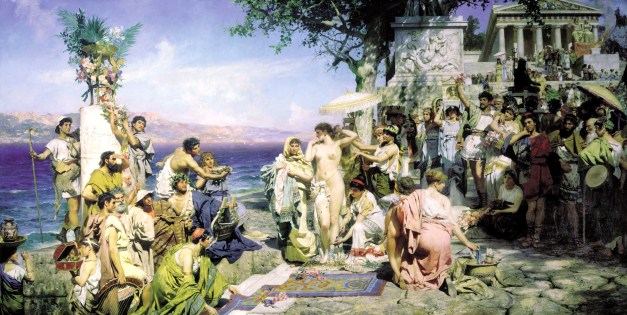
Phryne at the Poseidonia in Eleusis, by Henryk Siemiradzki (1889)
Eleusinian, Cabeirian and Orphic Mysteries
-
● The Eleusinian mysteries (Ἐλευσίνια μυστήρια) were initiation ceremonies held every year for the cult of Demeter and Persephone based at Eleusis. Of all the mysteries celebrated in ancient Hellas, these were held to be the ones of greatest importance. Most likely their basis was an old agrarian cult which may go back to the Mycenaean and Minoan periods. The mysteries represented the myth of the abduction of the daughter (“korē”) from her mother by the king of the underworld, Hades, in a cycle with three phases: the “descent”, “search” and “ascent”, when Persephone was reunited with Demeter. Her resurrection was symbolic of the rebirth of all life. The rites, ceremonies, and beliefs were kept secret. Since the rituals involved visions and conjuring of an “afterlife”, some scholars believe that their power and longevity came from psychedelic agents. The only requirements for membership were freedom from “blood guilt”, meaning never having committed murder, and also not being a “barbarian” (unable to speak Greek). Nevertheless, the festival later spread to Rome. Women and even slaves were also allowed initiation. Comparative studies show parallels between these Hellenic rituals and other similar systems in the Near East, such as the Egyptian cults of Isis and Osiris, equivalent Syrian and Persian cults and, of course, the Thracian–Phrygian Cabeirian mysteries.
-
● The Cabeiri (Κάβειροι) were enigmatic chthonic deities, protectors of sailors, who were imported into Hellenic ritual keeping Hittite and proto-Etruscan elements. They were worshipped in a mystery cult associated with that of Hephaestus, and centered οn the north Aegean islands of Samothrace and Lemnos, and also at Thebes. Other places of worship included Imbros and Seuthopolis in Thrace, or various sites in Macedonia, Asia Minor and the rest of the Aegean. The Samothracian cult spread during the Hellenistic period, eventually initiating Romans. As the cult’s origin was non-Greek, the “barbarians” were also accepted: the initiation had no prerequisites for age, gender, status or ethnicity. Everyone, men and women, adults and children, the free or enslaved, the Hellenes and non-Hellenes, could participate.(3) After all, both the Samothracians and Lemnians were originally non-Greek: the latter might have been related to the Etruscans; they were Hellenized after Athens conquered Lemnos in the 6th century; but the cult of the Cabeiri survived the operation of Hellenization. The Samothracians were associated with the Trojans and Pelasgians. In the Sanctuary of the Great Gods,(4) they used a so-called “barbarian” language even in Roman times. Thebes was linked to Samothrace through the marriage of Cadmus and Harmonia, the Samothracian. The Cabeiri bear many similarities to other fabulous races, such as the Telchines, Cyclopes, Dactyls, Corybantes, and Curetes. These groups were often confused or identified with one another, since many of them were also associated with metallurgy – just like Hephaestus.
- (3) A Samothracian relief showing Agamemnon being initiated into the Cabeirian rites gives credit to the idea that the Eleusinian mysteries originated from the Cabeirian cult through Thracians who settled at Eleusis.
- (4) The famous Winged Nike (Victory) of Samothrace (c. 200–190 BCE) stood at the island’s Temple complex, on a rostral pedestal representing a ship’s prow, and dedicated to the Great Gods.

The Myth of Orpheus, by Marc Chagall
-
● The Orphic (Ὀρφικά) mysteries may have also had their origins with the Cabeiri. They were religious beliefs and practices originating in the Hellenic and Thracian worlds, but associated with poetry ascribed to the mythical musician and prophet Orpheus, who descended into Hades for his beloved Eurydice and returned. Orphics also revered Persephone and Dionysus for the same reason. Initiation into Orphism, as in the case of the Eleusinian mysteries, was associated with an “afterlife”.(5)
- (5) In 390 CE, Emperor Theodosius I ordered his troops to commit a most horrific massacre, one of the worst in all history, slaughtering 7,000-15,000 Thessalonians in the Hippodrome, because they had rebelled against his Germanic mercenaries. To expiate his sin, two years later, in 392, he closed all ancient sanctuaries by decree, and imposed Christianism as the sole religion, with the abolition of the Edict of Milan (313 CE) on freedom of religion. Thanks to Theodosius, the “Saint” (for the Church), or the “Great” (for History), as soon as the Christians were free from persecution, they started persecuting all the others! The last remnants of the Mysteries were wiped out in 396, when another German, the Christian Alaric, invaded Eleusis with many local Christians “in their dark garments” – the “Blackshirts” of the era – desecrating the old sanctuaries and killing all priests. Having ravaged Attica, the “Messiah” of the Christian mob entered triumphantly Athens. Then he invaded the Peloponnese, sold citizens of Corinth, Argos, Sparta, etc. into slavery, crossed the Gulf of Corinth and marched to Epirus, halting plunder and slaughter only when he was made a magister militum by the emperor. He surely deserved better: sanctification! (See Chronicles 23-24, on the Massacre of Thessalonica and the violent Christianization of the Empire through The Genocide of the Hellenes and The Triumph of Cretinism).
-
● Apropos: Most of the Theodosian dynasty emperors, as well as the last ones of the Occidental Empire, were puppets of Germanic kingmakers, the so-called magistri militum (military masters) or stratelates, such as Aspar in the East, and Ricimer in the West. As for Alaric, he captured and plundered even Rome, in 410, marking the beginning of the end of the Western Roman Empire.

The choral dancers frieze from the Temenos in Samothrace
After the conquest of Minoan Crete, the Mycenaean foreign trade
took off: production of goods meant to be sold abroad increased.
COMMERCE REMAINS CURIOUSLY ABSENT from all the written sources in Linear B. However, it is known that the Minoans exported fine fabrics to Egypt; no doubt the Mycenaeans did the same. They probably borrowed knowledge and expertise from the Minoans on matters related to navigation, as is evidenced by the fact that their maritime commerce did not take off until after the collapse of the Minoan civilization. It seems that certain products, especially fabrics and oil, even metal objects, were meant to be sold outside the kingdom, because they were made in quantities too great to be consumed solely at home. Pottery was also produced in great quantities. Especially after the conquest of Minoan Crete, production increased considerably, notably in Argolis, the area of Mycenae, with great numbers exported outside Hellas. The products destined for export were more luxurious, featuring heavily worked painted decorations that incorporated mythic, warrior, or animal motifs, etc. The Mycenaean network extended as far as Spain, Britain, and central Europe, while their pottery has been found in Sardinia, Sicily, southern Italy, the Aegean, Asia Minor (amongst others at the old settlement of Miletus, where high-quality ceramics, Minoan or Mycenaean, have been recovered), other parts of Anatolia, Cyprus, Canaan and Egypt. The Minoan and Mycenaean maritime foreign trade is one of the most important chapters of the Bronze Age history, and an open challenge to every archaeologist or historian.
Trojan War, Bronze Age Collapse and Dark Ages

The gold funeral Mask
of “Agamemnon”
The Mycenaeans inherited the Minoan thalassocracy when they became masters of Crete; but they did not last long. The Trojan War, taking place in 1194-1184 BCE according to Eratosthenes,(6) the Sea Peoples’ raids, and the great instability of the era, led to their downfall during the Bronze Age collapse. Many historians think the transition to the Iron Age was violent, sudden and culturally disruptive. The Aegean and Anatolian palatial civilizations were replaced, after a hiatus, by the isolated village cultures of the so-called “Greek Dark Ages”, which were dark, indeed, but not only Greek. In just fifty years, in the first half of the 12th century, the downfall of the Mycenaean world and the Hittite Empire, the catastrophe in Syria, Canaan, and Egypt, and the cultural collapse that followed, resulted in the interruption of trade routes and the severe reduction of literacy. The Mycenaean Linear B script was forgotten. The Hellenes would need to re-invent writing in the late 9th or early 8th centuries BCE.(7) During that period almost every city was violently destroyed and usually left unoccupied thereafter, such as Mycenae, Hattusa, the capital of the Hittites, and Ugarit. Troy was destroyed at least twice before being abandoned. Fewer and smaller settlements suggest famine or war (or both), leading to decimation and depopulation.
- (6) Eratosthenes (Ἐρατοσθένης, c. 276 – c. 195 BCE), from Cyrene, was a geographer, astronomer, mathematician, poet and music theorist (characteristic of the ancient scholars’ polymathy). He was the first to calculate the circumference of the Earth, and also the tilt of the Earth’s axis, with remarkable accuracy. He may have also accurately calculated the distance from the Earth to the Sun. He invented the term geography, a system of latitude and longitude, and created the first world map with parallels and meridians in his cartographic depictions based on the available geographical knowledge of the era. He invented the leap day, and was the founder of scientific chronology, trying to fix the dates of the chief political and literary events from the conquest of Troy. (Regarding the timing of the Trojan War, see also Chronicle 16, footnote 6).
-
● Eratosthenes was a chief librarian of the Great Library of Alexandria in Ptolemaic Egypt. The library, a major centre of science and learning in the ancient world, was repeatedly destroyed by Romans (Julius Caesar in 48 BCE, Aurelian in the 3rd century CE), the Christians (Theodosius and pope Theophilus in 391), and Muslim Arabs (`Amr ibn al-`As in 642), resulting to an irretrievable loss of knowledge for mankind. (On burning of books and libraries, see also Chronicles 22 (the case of Democritus), and 23-24).
- (7) Greek alphabet: allegedly derived from the “Phoenician alphabet”, it was in turn the ancestor of numerous other European and Middle Eastern scripts, including Latin and Cyrillic. However, a very important change was made in adapting the Phoenician system to Hellenic by introducing vowel letters. The Greeks were obliged to make the same innovation twice because the vowels are significant in their language. When the Mycenaeans adapted the Minoan Linear A script to their needs, they borrowed 87 Cretan symbols; 82 corresponded to syllables and five to vowels. Linear A is still not deciphered and, therefore, we ignore if this brilliant idea of the vowel letters was Cretan or Hellenic. According to the definition used by modern authors, this feature makes Greek the first alphabet in the real sense, as distinguished from the purely consonantal Semitic “alphabets”, the so-called “abjads” (from the Arabic word for alphabet). The Phoenician abjad belonged to the family of the closely related West Semitic scripts. (On Balkan and Greek script, see Chronicle 3, last part: Early Balkan writing).
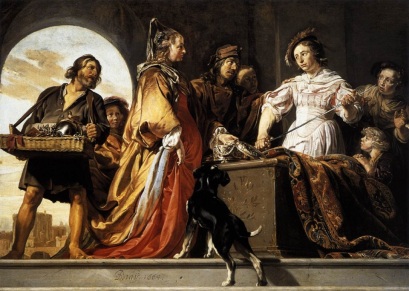
Achilles discovered by Ulysses (Odysseus), by Jan de Bray
The Trojan War was just an act of this tragedy on a big scale involving numerous ethnicities: the fighters in Troy’s alliance are depicted in the Iliad as speaking various languages and thus needing to have orders translated to them by their commanders. On the Greek side instead, the Trojan campaign was anything but pan-Hellenic: even the great hero, Achilles, tried to avoid the war disguised as a girl in the palace of Skyros but was exposed by Odysseus! The king of Ithaca too tried to evade “conscription” pretending to be mad! Areas such as Macedonia, Epirus, and in part Thessaly, stayed away, probably because they were under the control of the Dorians, who would proceed to the Peloponnese some time later, filling the vacuum created by the demise of the Mycenaeans. Up to 90% of small sites were abandoned and all palaces destroyed, suggesting depopulation on a major scale. Athens and some other cities continued to be occupied but with a more local sphere of influence, limited trade and an impoverished culture, from which they took centuries to recover.

The Temple of Poseidon at Sounion, Attica,
with its Doric order columns at sunset
The Dark Ages would last for more than 400 years. The decoration on Hellenic pottery, after circa 1100 BCE, lacks the figurative adornment of either Minoan or Mycenaean ware, and is restricted to simpler, generally geometric styles (1000–700 BCE). It’s the reason why this age is also called Geometric, or Homeric, due to the composition of Homer’s epics, circa the 8th century, in the context of the Epic Cycle. Those epics, a by-product of the new alphabet and inspired mainly by the Trojan War and its aftermath, which would later feed the tragedians’ imagination, also together with the emergence of the Grecian poleis, in the 9th century, were the first signs of recovery in Hellas.

The celebrated Winged Nike (Victory) of Samothrace – looted by the French, just like Aphrodite of Melos (Venus de Milo). Three Victories were found in the temenos: the second was snatched by the Austrians, while the third, at last, remained on Samothrace. The statue of the first Victory is 3.28 m high (with its wings) and 5.58 m with the marble ship’s prow on which it stands.
The catastrophe was even worse in Anatolia. Every important settlement shows a layer of destruction. Here civilization possibly did not recover to the level of the Hittites for another thousand years. Cyprus witnessed two destructive waves: by the Sea Peoples (c. 1230), and Aegean refugees (c. 1190 BCE). Ugarit, in Syria, was burned to the ground. In addition, the coastal cities from Gaza northward sank into havoc. Nevertheless, paradoxically enough, the raids did not affect the Phoenician cities; they were confined in southern Canaan. Assyria, protected by the best army in the world, also remained intact; but was obliged to withdraw to its borders for a very long time. As for Egypt, although victorious against the invaders and surviving for a while, it succumbed some time later.
Robert Drews describes the Bronze Age collapse as “the worst disaster in ancient history, even more calamitous than the collapse of the Western Roman Empire”. A number of people nostalgically referred to the cultural memories of the disaster as stories of a “lost golden age”, when “civilization was wiped out”. Hesiod spoke of Ages of Gold, Silver and Bronze, separated from the modern harsh and cruel world of the Age of Iron by the Age of Heroes. It seems that, as a result of the Bronze Age collapse, the disruption of long distance trade, an aspect of the so-called “societal collapse”, cut easy supplies of tin, making bronze impossible to produce.
The disruption of long distance trade cut easy supplies of tin,
making bronze impossible to produce (a “societal collapse”).
Next Chronicle 19. PHOENICIA’S STROKE OF FORTUNE ● Phoenicians and Sea Peoples ● Minoan Eruption on Thera ● Trojan War and Bronze Age Collapse (B)




